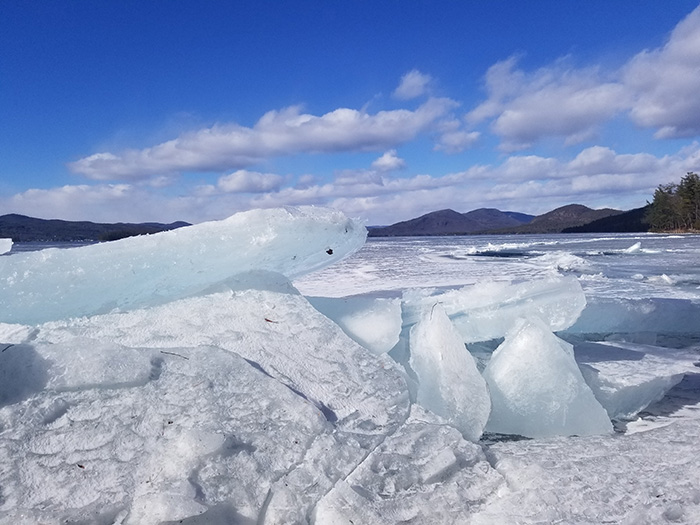By Bob Weinman, Special to The Chronicle
Editor’s note: In 2021, Bob Weinman of Queensbury set out to kayak the length of Lake George in every month of the year. This is the third dispatch in a monthly 12-part series.
Paddled it. Skied it. Today — in March 2021 — I was going to bike the length of Lake George.
Inspired by photos of folks fat-biking frozen lakes in Truckee, California, I rented a fat-tire bike from the Grey Ghost Bicycles in Glens Falls.
“Is the ice thick enough?” my friend Bee asked as she drove north on Route 22 towards Ticonderoga.
“Absolutely!” I replied, while stuffing caffeine-infused Clif Bars into my backpack.
“Did you call Fish307?”
“Yup. All’s good!” I replied. She was referring to the local tackle shop that provides updates on Lake George “Hard water” conditions. I discovered them after my ski journey in February when I nearly schussed into open water by Hague. I reflected on that near miss.
“Okay, just to make you happy, I’ll call ’em again.
“Again” was a lie, I had called them two days ago, but ice can’t change that quickly! Two minutes later, I learned, it can.

I looked at Bee. She looked at me. Noting my melted mood, she pulled over.
My beautiful full-bodied fat-tire bike lolled in the back seat, destined to remain un-adventured.
“Early lunch?” I asked.
“The Railyard” in Whitehall, Bee replied. “Your treat.”
We exchanged a smile, quietly acknowledging that she had just saved my scruffy hide. It wasn’t the first time. It’s important to listen to friends. It can make for nice conversation and sometimes they can save your life.
Plans disrupted, but hopes intact, I anxiously awaited ice-out to paddle, instead of bike, the lake in March. My good friend Chris became my eyes on the Lake. His knowledge as a kayaker, plus his regular commute from Sabbath Day Point to his job at Lake George Waterkeeper in the Village provided the best report if the lake was passable.
Chris, like me, is a chronic optimist. For decades now he has been a loyal friend to Lake George trying to keep her clean and clear so she can continue to defend her title as Queen of American Lakes. Chris understands that being a natural beauty (the lake, not Chris) is both a blessing and a curse. Everybody wants to enjoy the lake, and they should, but beauty requires a balance of both admiration and respect. Impacts including land use, road salt and aging septic systems can compromise our Queen’s complexion and the Waterkeeper uses science, engineering, community and genuine love with the intent to keep Lake George in her prime for a long time.
Chris paddled the lake with me before when he helped coordinate LOVE the Lake. The weekend event involved paddling the length of the lake and included a few restoration projects along the shore followed by live music from Steve Zaccari’s Hallertau Band at the finish line in Shepard Park. There was even an unofficial effort to race Bill Dow’s paddlecraft, the Minne-ha-ha as she returned from her 1-hour tour. I have a particular fondness for the Minne-ha-ha as we share the same birth year and I have discovered she creates a winsome little wave train that can be kayak-surfed from a safe distance.
Celebrated 2 paddlers who died on LG
LOVE the Lake was created to remember two paddlers, Steven Canady and Peter Snyder, who lost their lives in separate incidents on the lake and to appreciate the beauty of the lake and the community on and around it.
The casual event grew over the next few years, and together with help and encouragement from Chris, Mayor Blais, Patty from Patty’s Watersports, my friends Steve and Bonnie, and my family, we inspired the American Canoe Association to participate. The ACA, after all, was born on Lake George in 1880. The event has since waned, but the spirit of it still encourages me to get to know my lake at least once a year by paddling it.
Several weeks passed, news from Chris was grim, the darn ice remained stubbornly in place. I passed the time kayaking through ice on the Hudson River near my home in Queensbury. The kayak is a 5,000-year-old creation (mine is a little newer) of the Inuit, Aleut and Yup’ik people living in Alaska, Canada, and Greenland. Plenty of ice up there, I just needed to practice the Eskimo techniques for paddling about ice, minus the polar bears.
On Friday, March 26th, the last weekend of March, I repeated my habit of hiking Stewarts Ledges near Buck Mountain to check the ice. The view revealed large segments of ice still locked in from Lake George Village to the Narrows.
It also revealed friendly channels of open water. I’m a glass half-full type of soul so I headed down to my family’s dock on Assembly Point to check the ice more closely. A nasty west wind was pushing a massive sheet of ice toward our shore.
Ice sheet on move didn’t damage dock
I cringed in anticipation of the sounds of snapping timbers as our dock bowed to the ice, but no, the ice hit the dock with the chime of breaking crystal. The heavy rains that week had honey-combed the ominous ice island reducing the collision to a tender kiss. It was a sign.
I packed that night and was at Mossy Point at the crack of dawn the next day. That is if you call noon the crack of dawn. A light tailwind was in my favor, and with long spring days, I committed to paddling the full length in one push. If I encountered ice I would turn around, find the first inhabited home, and beg for hot chocolate, pasta and a bed.
Unbeknownst to me, Chris had paddled that same morning from Sabbath Day Point. He sent an e-mail warning me that the lake was still locked with ice just south of Vicar’s Island. My phone, on signal sabbatical, was unwilling to share this information, so I continued south, sailing on ignorance and optimism.
Arriving at Odell Island I was drifting in a mixed cocktail of ice cubes and clear water. I decided to press on, confident that Hulett’s Landing could be a safe bailout. By 5:30 p.m. I found myself in relatively open water and said a quick, floating prayer by the Chapel of Isaac Jogues on Hecker Island. I use Mark 4:41 often when paddling, “Who is this, even the winds and waves obey him.”
Hope and a prayer, I paddled on.
I found thick ice in the protected coves and bays of the Harbor Islands, Black Mountain Point, and Paradise Bay, but the main channel was open with a few rogue floaters. Then, the sun set, and I was alone, with only the waxing Worm Moon of March to lead my way.
I pressed on, reaching Tea Island at 10:10 p.m.. I was amazed at my luck. Wind, waves, and ice had cooperated.
Turning my kayak northeast, I sprinted past Diamond Island and into Dunham’s Bay. I could see my neighbor’s lights and our dock just two hundred yards away.
Then, ‘Crunch.’ My bow hit ice. I pressed on expecting the ice would give way. Several attempts and forty minutes later I realized the full meaning of ‘so close but yet so far’. Reluctantly I turned my boat south towards Dunham’s Bay Lodge and made several attempts at the east shore till I finally found a hidden channel in the darkness. I sprinted, hoping the moving ice would stay put long enough for me to make shore. Thirty minutes and a quarter mile walk later, I warmed my cold toes by the fireplace in our camp.
‘Bing,’ Chris’s warning e-mail belatedly reached by my phone. It is a vindictive little device, that phone.
Winter still lingered in the corners of the room too distant from the fireplace just as the ice lingered in the shade of Dunham’s Bay, reminding me that spring is a fickle promise of summer and, while we can appreciate the optimism it brings, we should also respect that winter can be a persistent bugger.
Copyright © 2022 Lone Oak Publishing Co., Inc. All Rights Reserved
 Glens Falls Chronicle Serving the Glens Falls/Lake George region; Warren, Washington and northern Saratoga counties since 1980
Glens Falls Chronicle Serving the Glens Falls/Lake George region; Warren, Washington and northern Saratoga counties since 1980


